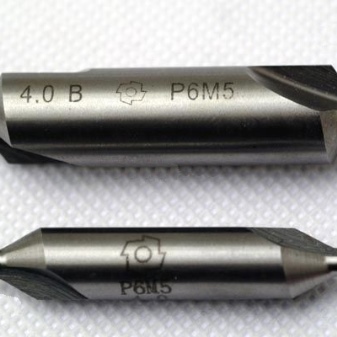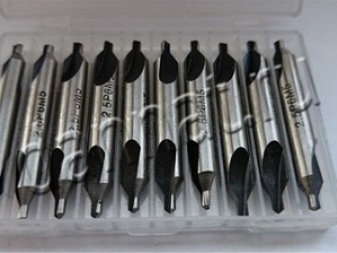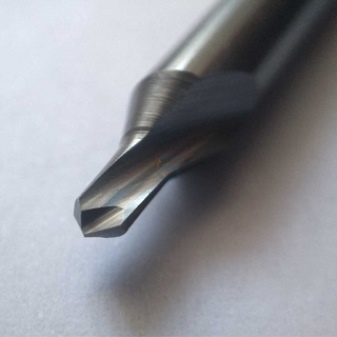What are center drills and how to choose them?

The center drill is a professional-type multifunctional tool. This combined product has 2 working parts, the use of which makes it possible to perform various operations. The main function of the drill is to make holes in workpieces of various hardness and density - in alloy steel, cast iron, cermets, and polymer plastics. Drills of this type can be used both in domestic conditions and on metal-cutting production equipment.


What is it and what is it for?
In appearance, the centering type of the drill differs from the standard drill for metal. In this case, the tool has 2 working parts, which are located at opposite ends of the working rod of the tool. This approach makes it possible to use the drill for a longer time without sharpening. The main feature of the product is its reinforced body, which is three times thicker than its self-centering cutting parts. The centering tool, when compared to a conventional drill, has a short body and small working parts. This modification gives the tool the properties of increased hardness and reliability. When working with this drill, it does not bend, very rarely breaks and makes it possible to make holes with a high degree of accuracy.
The self-centering drill is made of 3 main parts:
- the area of the drill attachment in the drilling equipment - the base of the tool;
- the area of the smallest diameter - the working cutting part;
- the area of greatest diameter is the part of the middle size.


The drill is used to perform metalworking procedures in various types of turning, drilling and milling equipment. When performing production tasks on a mass scale, a centering tool is used to mark the center of a workpiece before placing it in a machining machine. In this case, the process of tilting the workpiece can be skipped, which simplifies the production cycle and reduces the time of its implementation.
Due to its widened part and high degree of rigidity, the centering device is used to make exact dimensions of the hole diameter, therefore it is often used in software-controlled equipment.


This device has minimal risks of deformation or breakage, therefore, in the construction industry, the drill is used as a countersink for metal or wood. The device not only has the ability to drill a preliminary hole for the self-tapping screw, but also perform counterbore at the same time in order to completely sink the hardware head into the material.
In some cases, a center drill helps to drill the heads of screws and self-tapping screws with knocked down splines. Even radio amateurs have found use for this tool - small drill diameters are used to drill holes in radio boards. Standard drills often break when performing such work, while a self-centering device with a size of up to 1.5 mm, due to the design feature, flawlessly copes with the task assigned to it.


Technical requirements
Carbide drilling tools are manufactured according to the requirements of the state standard, which is regulated by GOST 14952-75.Using this device, it is possible to make a hole with a precise diameter, which is located in a direction at right angles to the working surface. Any other devices are significantly inferior to a center drill in terms of reliability and accuracy of holes.
According to GOST standards, the diameter of the centering device can be in the range of 0.5-10 mm. There are 4 types of such a drilling tool.
- Type A - Necessary when making precise holes, the centering of the taper of which is 60 °. This type of tool does not have cutting edges that form a safety cone during drilling.
- Type B - used for drilling a hole with a safety cone, the size of which is 120 °.
- Type C - used for holes with exact centering, but without the use of a cone safety device. In this case, the turn of the sides of the hole will be 75 °.
- R type - used for drilling a hole that is accurate in diameter, the turn of the sides of which has a cut in the form of an arc.


Center drills of the listed types are manufactured in 2 variations:
- the diameter of the cutting part reaches no more than 0.8 mm;
- the diameter of the cutting part is greater than 0.8 mm.
When using a drilling tool, the diameter of the cutting part of which is less than 0.8 mm, the smoothness of the walls at the hole is much higher than that of analogues. With a cutting surface of more than 0.8 mm, this feature is decisive when choosing the type of drill, the use of which gives a different degree of roughness of the finished hole. The tool designed for drilling centered holes is made of hard steel alloys with high speed characteristics.
In accordance with the GOST standards, the Rockwell hardness of the product, depending on the diameter, is as follows:
- diameter up to 3.15 mm - has a hardness of 62-65 HRC;
- diameter over 3.15 mm - has a hardness of 63-66 HRC.


Some manufacturers make even stronger center drills by adding cobalt and vanadium components to the alloy.
When making a center drill, small deviations in its diameter are permissible. These indicators are also regulated by the state standard:
- diameters up to 0.8 mm may have a larger error of 0.05 mm;
- diameters from 0.8 to 2.5 mm may have an error of up to 0.1 mm;
- diameters from 2.5 to 5 mm may have an error of up to 0.12 mm;
- diameters over 5 mm may have an error of 0.15 mm.
GOST standards also regulate the appearance of the drilling device. There should be no cracks and chips, traces of blackening or oxides on the surface of the tool. Oxide colors can appear in the groove area of the drill without going beyond the sharpening circle.


Popular manufacturers
Currently, retail chains offer customers a centering drilling tool of domestic and foreign manufacturers. The cost of these items depends on the brand that has released the products. Domestic drills are of high quality at lower prices compared to products of foreign origin.
Among domestic producers, the most popular among consumers are the products of Sekira LLC. The company is located in the Sestroretsk District of the Leningrad Region.
Center drills are produced here in accordance with national GOST standards. Without re-sharpening, a tool from this manufacturer can perform about 120 drilling cycles.



With regard to products coming to our market from abroad, the Dormer UK brand is of particular interest. Center drills are manufactured in the UK and meet international technical standards. The alloy steel for this drilling tool contains a cobalt alloying component, which is why Dormer drills have high strength and excellent cutting performance.The tool is resistant to heat and has increased wear resistance.
The American brand DeWALT and the German brand Robert Bosch have good reviews for the quality of the centering tool. Of the Asian manufacturers, the instrument of the South Korean brand YG-1 deserves trust. As for the Chinese quality, you should be very careful when choosing a center drill from these manufacturers, since products that are outwardly attractive in appearance may turn out to be of poor quality.



Selection Tips
The choice of a center drill will depend on what hole dimensions you want to make. The weight of the workpiece, which is fixed in the metalworking machine, is also taken into account. Sizes, depending on the weight of the workpiece, are regulated by GOST - the greater the mass of the part, the larger the drill diameter is needed. Each drill diameter has 2 versions, so its type is selected depending on the requirements for the roughness of the hole walls.
The combined centering drill is selected according to the requirements for the type of holes specified in the design drawings. To determine the quality of a tool, there are a number of items for which it must be checked.
- Compliance with Rockwell hardness standards. The center drill data is indicated in its technical data. A quality tool has an indicator of at least 63-66 HRC. Exceeding these standards leads to the fact that the drill will be fragile and short-lived. Understated standards will cause the tool to become dull very quickly.
- Conformity of the drill to the declared diameter. You can check this with a micrometer. The elongated working pen of the drill is to be measured - and if its diameter exceeds the permissible error rates, it will not be possible to obtain a hole of a given size using this tool.
- Determine the integrity of the product. This is especially important for its cutting part, as well as for the cone-shaped crown. There should be no cracks or dents on the tool in place of the working surfaces.


When choosing a center drill, it is better to give preference to well-known brands with a well-deserved positive reputation. You should not purchase a drill from an unknown manufacturer - saving money, you can buy a tool of inadequate quality, which will quickly fail.
The drilling tool gradually changes the angle of the cutting plates during operation. This leads to a decrease in the speed of the cut and excessive heating of the drill. Over time, any drill requires sharpening, which must be done while maintaining the angle of inclination of the cutting edge.



Sharpening
In everyday life, a centering drill is used for drilling metal blanks or as an auxiliary tool when unscrewing problem hardware. You can sharpen such a drill on your own, but with this procedure it is necessary to observe some important nuances.
- For the convenience of performing work, it is recommended to use special electric machines designed for sharpening drilling tools. Without using such a device, it will be quite difficult for you to maintain the correct angle of sharpening of the cutting surface of the center drill.
- For sharpening, you need to know exactly the diameter of the tool. Usually this information is indicated on its body.
- The tool is placed in a hole corresponding to its diameter. The sharpening process is performed automatically by the device without human intervention.
- After the end of the sharpening process, the surface of the tool must be cleaned of waste metal shavings.
In cases where the angle of the cutting part of the center drill is violated during sharpening, during use the tool begins to overheat unnecessarily and wears out quickly.


In the next video, you will find an overview of center drills for installing furniture fittings.













The comment was sent successfully.